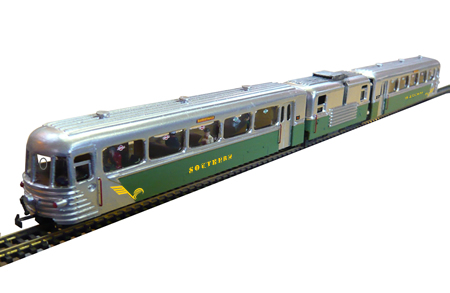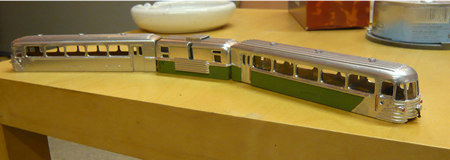|
Building a second prototype
railcar

railcar N0 201 'Atlantic Airstream' -
click on image to enlarge
The experience gained
operating the prototype railcar No 200 resulted in a number of
improvements being incorporated into the production version.
The wheelbase of the
central tractor unit was slightly lengthened to provide more room for
parcels and small goods. In addition, Armstrong hydraulic dampers were
fitted to control roll. Additional exterior linear radiators were fitted
to the car in order to reduce interior temperatures. These were hidden in
modernistic fins.
The passenger cars
maintained a similar configuration with some important changes. The roof
was built as an integral part of the car and was provided with folded
corrugations to reduce 'thrumming'. The driver's compartments were
separated by a bulkhead and door and further modern aerodynamic styling
incorporated into the design.
Due to pressures at
Eastleigh, the contract for the second railcar was awarded to
Short Bros. of Rochester. Better known for building flying boats, they had
nevertheless successfully built a number of lightweight tram and bus
bodies for many companies throughout the British Isles.
The choice of builder was
an inspired one. The overall weight of the units was kept to a minimum and
the undoubted panel working skills of Short Bros resulted in handsome cars
produced in aircraft alloy albeit expensive.
This time, the basis for
the railcar was a Riverossi N scale diesel loco, which seemed to us
to run a bit better than the Farish version. It is fitted with a Digitrax
DZ125 chip. The Riverossi chassis has very deep flanges and we have had to
slightly modify our points (deepening flangeways) to prevent derailments.
Construction methods are
largely similar to the first railcar. We built up the complex curves using
soft sand bodyfiller. The silver paint was supposed to burnish (it did
not). Sadly an application of another type obscured much of the detail and
the model was ruined. The chassis of this railcar has now been transferred
to the new railcar 302 and the rest is scrapped.

the completed bodies after spraying with
silver paint - click image to enlarge

approaching completion - click image to
enlarge

|